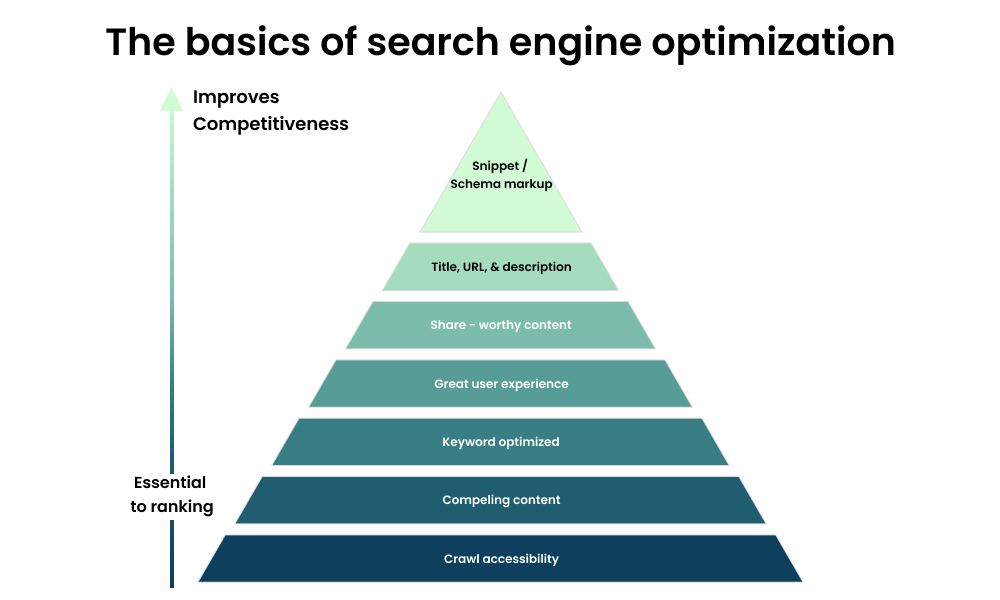
Search engine optimization (SEO) consists of improving a website’s ranking in search engines and thereby boosting its traffic from search engines.
The objective of SEO is to target unpaid traffic (also known as “organic” or “natural” results) rather than direct traffic or paid traffic.
The crucial difference between SEO and paid advertising is that SEO involves “organic” ranking, which implies you don’t pay to be there in space. Search machine optimization means taking a chunk of online content and optimizing it, so search machines like Google show it towards the highest of the runners when someone searches for a commodity.
A search engine optimization strategy examines the way search engines function, the algorithmic rules that govern the behavior of search engines, what people search for, the actual terms or keywords typed into search engines, and which search engines people prefer to use.
SEO is not just about optimizing any website but, as a matter of fact, SEO is and should be a part of other disciplines within digital marketing, such as:
- Content marketing
- Public relations
- Branding
- Conversion rate optimization
- Coding and web development
- Content design
- User experience (UX)
- Lots more
The significance of search engine optimization and placement
This is one of the cases where the significance of SEO and placement comes in. SEO applies not only to the online content but to websites or web pages in their entirety. It generally refers to a strategic process in which an SEO specialist takes an applicable way to improve specific point visibility in search results produced by search engines similar to Google and Bing.
In other words, your efforts to earn a favorable ranking in search engine results can be seen as a combined effort. When you consider the fact that most web surfers do not possess a great deal of patience, the relevance of search engine ranking becomes particularly apparent.
Almost everyone who uses search engines agrees that they rarely visit the second page of results generated by a search engine. Considering that search engines represent a significant proportion of the avenues through which surfers locate and access websites, it is evident that if your site doesn’t rank highly in search engines, it is likely to receive only a few visitors.
What Are the Benefits of SEO?
In this article, we will explore a number of the foremost significant benefits of search engine optimization for businesses looking to extend visibility and serving a valuable purpose.


1. The SEO process increases organic discovery and quality website traffic
One of the major advantages of SEO is organic visibility, which increases website traffic. Search engine optimization is customer-focused and hyper-targeted. Your web pages will be delivered to a relevant audience via relevant search queries when you use an effective SEO strategy.
Since the user is already trying to find what you have got to supply, organic visibility drives high-quality traffic to your website without trying to entice or persuade the visitor.
2. SEO Provides Impressive ROI
When gauging digital marketing channels, return on investment (ROI) is usually a precedence contemplation, if not the most crucial one. While SEO results take time, a high-quality strategy eventually delivers emotional ROI.
Search Machine leads offer a close rate of 14.6, nearly 12 lower than traditional marketing – indeed so, if your website ranks at the bottom of runner two, three, four, or not at each, leads will probably be missing. On the other hand, the first Google table receives 33 of all search traffic. Search Machine visibility directly correlates to boosted web business and increased profit, making ROI one of the most meaningful SEO benefits for multitudinous companies.
3. SEO enhances credibility and trust
Credibility is amplified among potential clients when you rank on Google’s first page. On Google, dozens of factors contribute to a website’s ranking, including the quality of the content, the speed of the site, and the usability of the mobile version. Even though the majority of consumers don’t pay attention to these signals, they expect Google to display relevant, valuable content first.75% of users don’t move on to page two because they trust the algorithm implicitly.
Credibility is built by a high-quality product or service and search engine authority.
4. SEO offers 24/7 promotion
Even after work hours, search engine optimization efforts continue. Like paid advertising, content does not disappear after a budget runs out. Your website will be promoted 24/7 through SEO, taking advantage of (at least) 60,000 Google searches per second. A unique point of SEO is that it lets your company reach druggies when they are looking for you-not just on a billboard spotted on the way out of the city.
5. The SEO process targets the entire marketing funnel
SEO – driven content marketing includes a species of content types that aims at every stage of the marketing channel. In the short term, top-of-the-funnel or middle-of-funnel blog posts won’t convert, but they set up brand loyalty and awareness – which lead to conversions.
6. Using SEO, you can reach your entire target audience
SEO is not only for companies that have a single target audience. Using a similar service for companies aiming at different audiences is equally effective.
7. SEO Improves User Experience
User experience is an integral element of SEO and a significant Google ranking factor. A Google stoner expects to have his or her question answered in seconds. A visitor who clicks on a website and faces a poor user experience – such as mobile incompatibility or a shower of popups – will probably leave the site within seconds. High bounce rates tell Google that the web page isn’t valuable for the user, often performing in lower rankings.
8. SEO is Key to Search Visibility
We are, without a suspicion, living in a digital age. Organizations that want to make a strong brand should be visible on the internet. However, you are not going to get any clicks or be able to promote your business to anyone if you are not a runner one. Search engine optimization is now important for successful brand recognition.
The basics of search engine optimization
You may be familiar with Maslow’s ranking of desires. It’s a theoretical framework of psychology that places a higher priority on needs like air, water, and physical safety over more advanced needs like esteem and belonging.
According to this theory, it is impossible to meet the needs at the top unless you meet the basics first.
As part of Mozlow’s hierarchy of SEO needs, we created another pyramid to explain how people should approach SEO.


These seven steps to successful SEO can be followed based on this beginner’s guide:
- Make your site search engine-friendly by making sure it’s crawlable
- The searcher’s query is answered by compelling content
- Search engines and users are attracted to keyword-optimized sites
- Fast loading speed and compelling UX lead to a great user experience
- Linkable, citable, and amplification-worthy content
- To pull in high click-through rates in the rankings, focus on the title, URL, and description
- Make your website stand out in SERPs with snippets and schema markup
1. Make your site search engine-friendly by making sure it’s crawlable:
- Crawling: Searches for content on the Internet, checking each URL’s code/content.
- Indexing: Organize and store the content retrieved from the crawling process. In the index, a page stands a good chance of being returned as a result of a query.
- Ranking: The search results are ordered by most relevant content to least relevant to provide the best answers to a searcher’s query.
2. The searcher’s query is answered by compelling content
To create work that will attract organic traffic, writers should pay attention to these three points
- The trending topic should be chosen:
There is much more to picking a good topic than just free association. The content you write for your target audience must be determined by the preference they have, the factors that influence their decisions, and the exact words to use to drive action.
Dive deep into original communities, learn the sorrows of your “buyer persona.”
- Adding Semantic Relatedness:
As time passes by, Google continues to evolve and get smarter about how it understands words and term connections.
To maintain the pace with the hunt machines, you need to enhance your keyword exploration and include more semantically connected words in your jotting to rank first.
- Raising Chances of Getting into Featured Snippet:
Google’s featured grain is a commodity all content generators conjure about because it guarantees maximum visibility for their textbooks and a serious increase in business flux.
There are no surefire fashions to take you to so-called “ position zero,” but some tactics are worth trying out.
- Identify the runners of your website that formerly rank in the Top 10 and try to optimize them for popular queries.
- Target question- grounded keywords and give structured answers (paragraphs, lists, or tables may come in handy then).
- Make sure you use title markers correctly.
3. Search engines and users are attracted to keyword-optimized sites
When it comes to SEO, the success of your organic hunt sweats rests largely on how effective you’re at discovering, probing, assaying, and opting for the right hunt machine keywords for your website. All other aspects of SEO calculate successful keyword optimization. What’s more, optimizing keywords touches every aspect of your SEO marketing sweats.
- Title Tag: Your target keywords must be included in the title label (and frontal loaded). This is the most important piece of content on your website, both on and off- runner.
- Links: Keyword optimization should be integrated into your link structure strategy. Internal links, inbound links, breadcrumb links, nautical links should all have your top optimized keywords. It’s also important to track and manage your link textbook sweats
- Content strategy: Still, you need to use your target keywords in your content, If you want to rank well and connect with the quest. WordStream for SEO helps combine keyword exploration with content authoring ( just saying …).
- Images: Don’t forget to optimize keywords in the filmland on your website. Target keywords should be used in your image alt trait and train names, to name many.
- Meta Description: There’s some debate over whether or not including target keywords in your textbook particles helps rankings. But there’s little mistrust that having optimized keywords in your meta markers produces more clicks, which is optimal.
- URL: Be sure to include keywords for SEO in train name slugs, as I’ve done with this runner’s URL. The runner is about keyword optimization, so the slug name is/ keyword-optimization.
- Site Structure: Keyword optimization is also critical to how you structure and organize your point content. Not only do you need to select the right keywords, but you need to group them creatively and order the corresponding runners on your website consequently.
4. Fast loading speed and compelling UX make for a great user experience
Still, then are some ways you can take to achieve a Google Page Speed score of 90 If you’re wondering how to ameliorate your website’s landing speed.
According to Google, speed plays a vital part in website ranking. It was blazoned about a time ago druggies will be notified if the runner they’re trying to pierce on their mobile has a poor loading speed. This gives a big threat of ranking veritably low and losing callers.
Although we were apprehensive of it for some time, we dreaded the day we’d have to start working on optimizing the product point because, let’s face it, optimizing a website is veritably time-consuming! You don’t know where to start, and you impinge into lots of pain points. You break one issue, and another one pops up. To put it in simpler words, it really takes a lot of time.
We tested our runner performance with the help of PageSpeed Perceptivity. We added our website link, and PSI did the rest. Besides furnishing a score that summarizes the runner’s performance, PSI creates a report, and what’s indeed more instigative, it also provides suggestions on what and how could be better.
Our first score was 30. It isn’t the most anticipated number for a UX company. We were surprised too, but we were happy to see the openings handed by the tool to begin our optimization. The tool suggested the following textbook contraction, duly sized images, junking of a videotape, and some unused CSS.
And to showcase the significance of these “ small adaptations” just by making these changes, we managed to score 68 one week latterly!
5. Linkable, citable, and amplification-worthy content
Creating content that’s useful, engaging, applicable, and link-good takes time, skill, and plutocracy. Then there are some tactics to make your content better of links.
Creating link-good content takes a lot of time, planning, and strategy.
The kinds of links you really need – given links ( i.e., natural links) – are generally the toughest to get.
So let’s talk about how you can start creating link-good content.
Link-good content is, simply, useful content. Link-good content generally comes in four forms
- Informational: This is generally the rearmost news.
- Inspirational: Any content that inspires people to take action, similar as tone- the enhancement or supporting a cause.
- Educational: This type of content teaches people a commodity that’s new to them.
- Entertaining: This type of content generally provides recreation and plays on the feelings of consumers (e.g., happiness, fear, wrathfulness, sadness, surprise).
Eventually, you want your content to be the stylish answer to a question being asked by someone in your target followership.
Still, when you’re writing content, you have no intention of creating a final product that nothing wants to link to If you’re like me.
Still, there’s no denying there’s a lot of medium content on the web. Most content fails to gain any traction – many (if any) views, shares, or links.
Creating stupendous content that attracts links isn’t easy.
This is relatively sad considering that 71.9 percent of marketers are concentrated on creating content, according to Hunt Machine Journal exploration.
The content competition is fierce. You’re contending with blog posts, infographics, vids, and so numerous further types of content for attention and clicks.
All too frequently, great content fails or is outperformed by commodity inferiority.
Think of content as an asset. Just like a rental property or stock, your content has the implicit to induce precious links that will help your SEO.
6. To pull in high click-through rates in the rankings, focus on the title, URL, and description
What Is Organic Click-Through- Rate?
Organic click-through rate ( also known as “ Organic CTR”), is the chance of a quest that clicks on a hunt machine result. Organic CTR is largely grounded on ranking position but is also told by a result’s title label, description, URL, and presence of Rich Particles.
7. Make your website stand out in SERPs with snippets and schema markup
It’s not sufficient for a website to just trend well in organic results. In a moment’s world where the competition is tough when it comes to performing well in hunt machine results runners (SERP), you need to calculate on different tools for your website to attract and to be on top of different SERPs. SEO and paid results aren’t enough these days if you want your website to reach a lot of implicit guests and to have a high chance of a conversion.
Google tools help your hunt machine results stand out by helping you influence SERP features. These tools help you edge your SEO. They help you recognize data on your website that’s precious to semantic hunt and hunt machines.
A rich grain is the structured data luxury that can be added to being HTML of websites to allow hunt machines to have a grasp and better understanding of the information available on each web runner. Typically, the hunting machine displays the title of the website, the URL, and the meta description of a webpage. When a rich grain is added, further information is displayed regarding the factual result. The hunt machines can show whether the result is a person, a business, a product, a review, or a commodity differently.
Then are some of the SERP rich particles that can make your SERP results stand out
- Video snippet
- Review snippet
- Knowledge panel
- Local pack
- Top stories
- Image pack
- Sitelinks
Conclusion
In the moment’s competitive request, SEO marketing is more important than ever. Search machines serve millions of users per day looking for answers to their questions or for results to their problems. However, If you have a website blog or online store, it helps to increase user traffic on your site.


